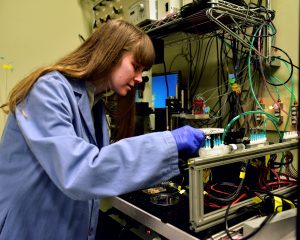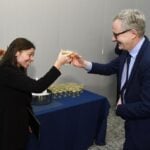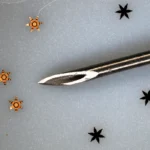Serendipity Leads to Simpler Method for Analyzing DNA

Unintentional scientific breakthroughs are not entirely uncommon, but the knowledge gathered from serendipitous discoveries brings a certain kind of excitement and inspiration to investigators about their research. Sarah Friedrich, INBT PhD candidate; her colleagues; and her mentor, Jeff Tza-Huei Wang, experienced this excitement when they unintentionally discovered a new method that drastically improves the process of testing DNA.
In many fields such as healthcare, forensics, and homeland security, concentrating DNA is a critical step for preparing samples for further testing. The samples, such as tissue, blood, and other fluids, can then be processed in different DNA testing devices. For example, in healthcare, concentrating DNA is necessary when searching for genetic defects or mutations. In standard practices, researchers focus and concentrate DNA in a solution by applying an external electric field. The electric field manipulates DNA because DNA molecules are highly charged. While Friedrich and her team were working to refine such a method, they observed that DNA spontaneously concentrated without the use of an electric field.

The new DNA concentration method can be used in many ways. Here Friedrich adjusts fluidic connections for an experiment to implement the new method in a microfluidic device.
What the team observed was a phenomenon they now call molecular rheotaxis (MRT). Rheotaxis refers to an organism’s movement toward or away from a fluid current. “The reason we called it MRT is because it reminded us of how fish orient their bodies with the water current,” said Friedrich. Friedrich’s method uses a pressure-driven fluid flow, which creates a secondary force acting in the opposite direction. It is the secondary force that concentrates the DNA.
The new method is simple, offers a range of applications, and has the potential to reduce the timespan needed to process and test samples. This means results can be achieved more quickly, which is important when testing for diseases or DNA abnormalities. For example, the method could be used in conjunction with other DNA test devices in point-of-care testing. This kind of testing could be done in a physician’s office, an ambulance, or a hospital rather than being sent to a lab for analysis.
Friedrich and her team hope the method could be used to improve the sensitivity of DNA testing to reduce the possibility of false-negative results. Furthermore, the method offers new possibilities for designing new DNA testing devices since electricity is not required.
Serendipitous discoveries require more than being in the right place at the right time. Friedrich and her colleagues had the right training, the right tools, and the curiosity to explore the phenomenon they witnessed. “That is one of the fun parts of science. You cannot always hypothesize what will happen,” said Friedrich.
Read the full journal article at Nature Communications





